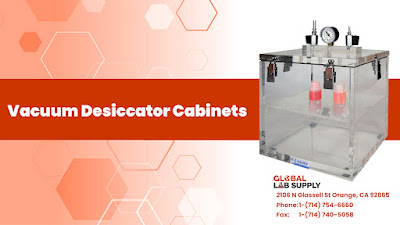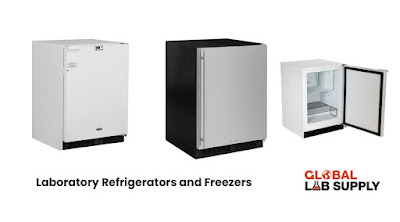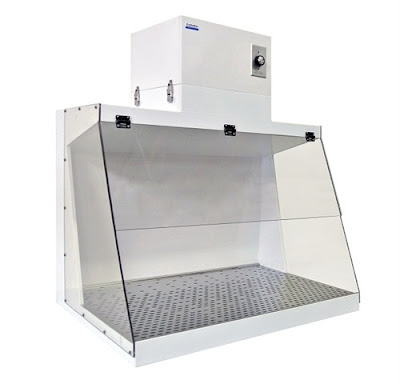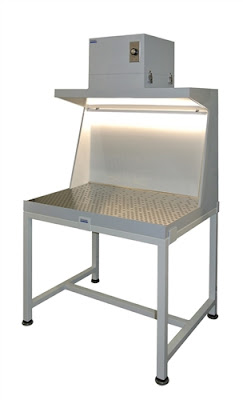Vacuum desiccator cabinets are used to store dust-free and oxygen-free chemical samples and medicines. Vacuum desiccator cabinets protect chemical compounds from oxidation reactions. Vacuum desiccator cabinets are available in a variety of sizes and chamber configurations. Cabinets with single chamber vacuum desiccators are used in small labs and hospitals. Cabinets with several chambers for desiccators are also available on the market.
Vacuum desiccator cabinets are safer than other types of desiccator cabinets. There are circular and rectangular vacuum desiccator cabinets available. Degassing methods are also carried out in vacuum desiccator cabinets.
Why are desiccator cabinets used?
Cabinets for desiccators are primarily used to hold chemical samples from the oxidation process. Vacuum Desiccator Cabinets have vacuum chambers built into the cabinets of the desiccators. The vacuum chambers keep the compounds safe from reactions with oxygen and the surrounding environment. It is also resistant to dampness. Chemicals are kept in a secure, airtight environment. Vacuum desiccator cabinets are used to store a variety of liquids, chemicals, and saline solutions.
These vacuum desiccator cabinets come in a variety of sizes and styles. Other types of desiccator cabinets on the market include plastic desiccator cabinets, stainless steel desiccator cabinets, and so on. Vacuum desiccators decrease humidity by blocking airflow with a vacuum pump or laboratory vacuum.
Some industry-standard characteristics of vacuum desiccator cabinets:
- The acrylic material is 1 inch thick.
- Type 1 has a removable cover that makes it simple to store samples.
- The front-hinged door allows for easy access to samples in all compartments (Type II)
- A suction gasket on the door guarantees an airtight seal.
- Vacuum level of 29.8′′ Hg and additional assistance provided by vacuum desiccators cabinets.
- Latches made of stainless steel to resist corrosion.
Pump Accessories - Vacuum Control Unit
The vacuum pump control device monitors the vacuum level within the desiccator's cabinet. It regulates pump operation by turning the pump on and off automatically. The cabinet chambers of the desiccator contain non-flammable and non-corrosive gases.
Vacuum desiccator vacuum pump
The vacuum pump protects the chemical compounds contained within the desiccator's chambers. It serves a vital function in preventing chemical compounds from oxidising.
The Benefits of Vacuum Desiccator Cabinets
- Cubic vacuum desiccator cabinets are easy to reach.
- Cubic vacuum desiccator cabinets offer more storage space.
- Vacuum desiccator cabinets are suitable for extremely dry environments.
- Cabinets with vacuum desiccators are meant to protect chemical compounds and biological samples from dust and humidity.
- The presence of a vacuum pump within the desiccator cabinet chambers protects the samples from oxygen and other ambient gases.
- Vacuum desiccator cabinets have robust and long-lasting acrylic walls and doors.
- The door and walls of vacuum desiccator cabinets are constructed of acrylic, which provides maximum protection for the samples contained within the desiccator chambers.
- Vacuum desiccator cabinets include a vacuum control device that adjusts the proportion of vacuum inside the chambers of the desiccator cabinet.
- The stainless steel door hinges on vacuum desiccator cabinets provide excellent protection for the chemical samples.
- The plating covered within the vacuum desiccator cabinet prevents the oxidation of the chemicals.
- Vacuum desiccator cabinets are used to keep chemical compounds and biological samples dry and free of dust. The vacuum pump technology is used in the design of these vacuum desiccator cabinets. The vacuum pump technology creates a consistent vacuum inside the chambers of Vacuum Desiccator Cabinets.
Vacuum desiccator cabinets use vacuum pump technology to operate as desiccator cabinets. A vacuum effect is created inside the chambers by the vacuum control unit located inside the vacuum desiccator cabinet. The vacuum keeps oxygen and other ambient gases away from the chemical compounds contained within the desiccator cabinet chambers.
The vacuum prevents chemical samples from reacting with the outside environment. Single chambered vacuum desiccator cabinets are simple to move from one location to another. Single chamber vacuum desiccator cabinets are lightweight and long-lasting desiccator cabinets designed for holding a small number of chemical compounds. Vacuum desiccators are offered in round and cabinet configurations. We can purchase them based on our requirements. Desiccators with several chambers are also available on the market.
Searching for Lab equipment? Contact Global lab supply today
While you are in search of the Vacuum desiccators cabinets, you can take help from Globallabsupply.com. This is a platform that can help you to choose the best in class lab equipment in this situation.



















